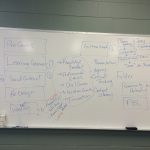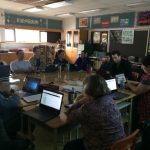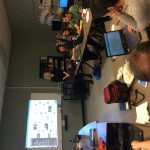Learning Spaces Help Set the Tone
The driving question to our project was … “How do we redesign the learning resource room to meet the needs of all learning styles, ultimately promoting a collaborative learning space?” This driving question will enable the teachers to have a focal point and reflect on how they can accommodate the needs of the students. They took into consideration elements such as functionality, inclusiveness, technology, and the different learning styles and profiles of students. At the end of the project, it was evident that there was much learning that occurred with the teachers in terms of technology and breaking away from the traditional method to teaching. Our vision to have a project-based learning school became more like a reality. This was very evident in the learning resource area.
Team Members
Nicole Battocchio
Algoma District School Board
Frank Calvano
Algoma District School Board
Danielle Jones
Algoma District School Board
Robert Zago
Algoma District School Board
Chantelle Anderson
Algoma District School Board
Professional Learning Goals
Learning Spaces Help Set the Tone
Building a collaborative relationship with other staff members is crucial to adjusting to change. Throughout this process of learning together, the group members have co-constructed lessons and collaborated together to create trusting relationships. This first step was successfully developed throughout this process.
Think Information Access
We have adopted a 1:1 ratio for computer access at our school. All students from grades 7-9 have their own school-supplied laptop. With this change in learning, teachers first sat with other staff members, administrators and students to create and co-construct a purpose technology would play in their learning throughout the year. It was established through this meeting that the technology would be used more intentionally to collaborate and share ideas. The focus would also be to have a “work smarter, not harder” approach with the documentation of student learning and provide descriptive feedback. Using technology to teach specific concepts within the curriculum was established. Throughout our journey, we have been able to become more familiar with Office 365 and OneNote to establish an area for teachers and students to collaborate with one another. Our online professional growth and learning have also evolved. The use of Twitter and Instagram as a way of communicating ideas and connecting with the public and sharing resources has been invaluable.
Activities and Resources
Use Technology with Purpose
Project-based learning classrooms prominently feature — and make full use of — educational technology. One of the key goals of project-based learning is to help students develop real-world skills and understand the professional world. Project-based learning is important in teaching students to conduct research, use spreadsheets or databases to organize information, and use video-editing and presentation software to transmit ideas. We made use of our Enabled Technology Lead at the board office and Donna Fry was a guest speaker who gave our team an introduction to Twitter as a professional learning platform. It was nice to create dialogue throughout the meeting and gain a better understanding of what “deeper learning looked and sounded like.”
Conversations with Collaboration
Part of the project-based learning philosophy was collaboration. This project helped us to see the value in taking the time to collaborate and work through challenges as they occurred. We were able to then push and model the collaboration skills within the classroom.
Unexpected Challenges
Change is always a slow process. Throughout our journey, we were trying not only to change our mindset on learning, but rather implement change amongst the students. We offered the students 1:1 ratio of technology, however, some at first were reluctant to use it. It becomes a challenge for students to adapt to this change, as well as teachers. We had to feel more comfortable with the technology and believe it would work for its original intent.
Time is always working against us in education. However, because the first step to our journey was developing relationships, the continuation of the collaboration will be further developed in the following year. Overall, we felt as a group we made many gains throughout this process.
Enhancing Student Learning and Development
Our project-based learning initiative has overwhelmingly been a positive experience for our students and staff. Just yesterday, we were interviewed by a researcher on deep learning. Sample questions that were asked: “What did the learning feel like?” and “What did it look like?” We had invited students around the table to speak of their successes and challenges with some of the projects. The response was so heartfelt and the teachers, who were present for the discussion and who had also taken part in the TLC grant, were overwhelmingly pleased with the student’s voice. The common themes discussed were stronger collaboration and how problem-solving skills were developed throughout the process. The teachers have intentionally planned for the collaboration to occur within the classroom, and the results were students felt proud of their accomplishments.
Sharing
Our project-based learning initiative has overwhelmingly been a positive experience for our students and staff. Just yesterday, we were interviewed by a researcher on deep learning. Sample questions that were asked: “What did the learning feel like?” and “What did it look like?” We had invited students around the table to speak of their successes and challenges with some of the projects. The response was so heartfelt and the teachers, who were present for the discussion and who had also taken part in the TLC grant, were overwhelmingly pleased with the student’s voice. The common themes discussed were stronger collaboration and how problem-solving skills were developed throughout the process. The teachers have intentionally planned for the collaboration to occur within the classroom, and the results were students felt proud of their accomplishments.
Project Evaluation
It is a lot of extra work to collaborate and create a new vision for your lessons. The extra time and effort put forth are evident through student and teacher testimonials about the positive experience they are having. We would, however, now intentionally plan our lessons with student voice and discussion.
The attendance rate in a voluntary lunch professional development hosted by teachers was high. Here we extended our learning with the use of technology in the classroom. Many valuable conversations were had throughout this time together.
The number of followers on our Twitter and Instagram accounts are a testament to the success of our project. # WP Driven Many teachers have embraced this new way of being informed about what’s going on in education by following and tweeting for the first time. They continue to make connections and network with other educators.
All three factors mentioned above indicated that the traditional mindset shifted as it embraced a new pedagogy.
Resources Created
These resources will open in your browser in a new tab, or be downloaded to your computer.




